Maybe, just maybe, the motivation for this behavior isn’t so obvious after all…?
Those who saw yesterday’s post know I had a very rewarding session with a mated pair of Hooded Mergansers two days ago. Most of the time the two of them were real lovebirds, never getting further away from each other than a few feet no matter where they went or what they were doing including fishing, resting in the water or on logs and moving away from potential threats (they were extremely wary and shy). They stuck to each other like glue.
But I just can’t quite be confident of what the motivation was for one of their behaviors that was contrary to everything else I saw. I’ll document it with photos and then at the end explain my confusion. Some of the images are of mediocre to poor quality because of very fast-moving birds, subjects who turned their backs to me, poor lighting because they moved into the shade of nearby plants with the sun low in the sky and good ol’ operator error (the cameraman screwed up).
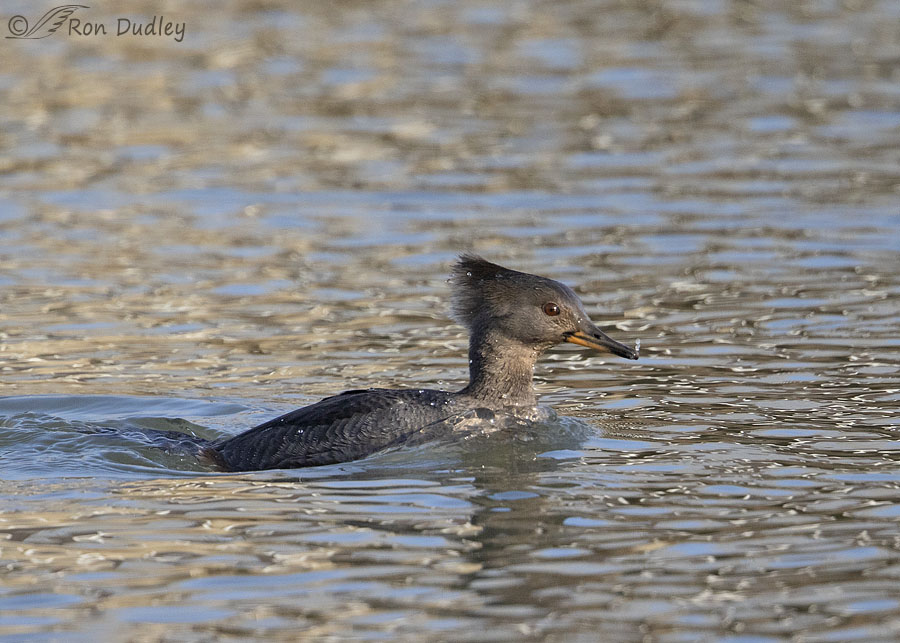
I had my lens on the female when I saw her accelerating to my right toward the general area where I knew the male was. I immediately wondered if she was going after a fish he might have caught while I was watching her.
I was right, he’d just caught a weather loach. Most fish that birds of various species catch in this area are weather loaches. This was one of the larger loaches I’ve seen and…
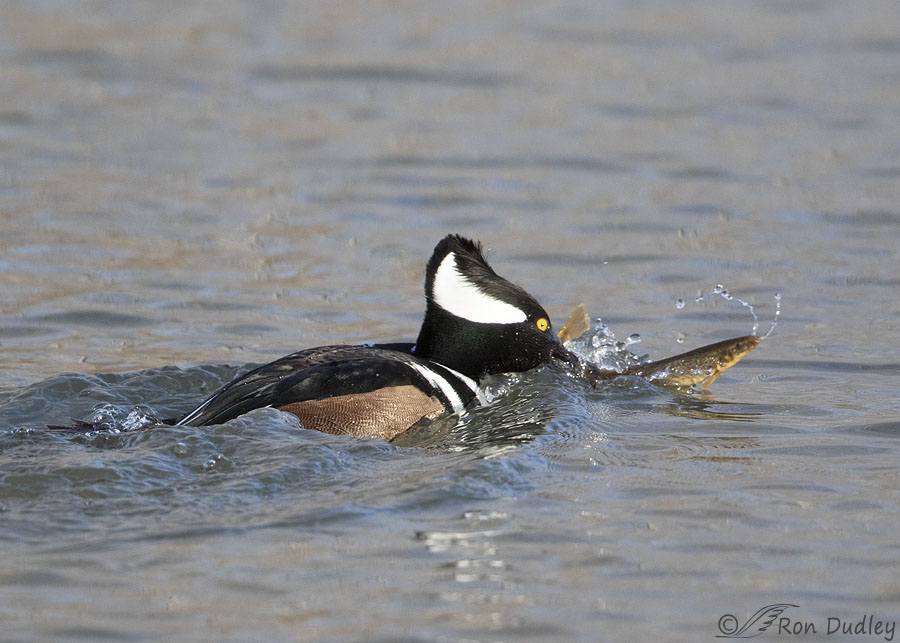
he was having trouble hanging on to it, much less getting it down the hatch.
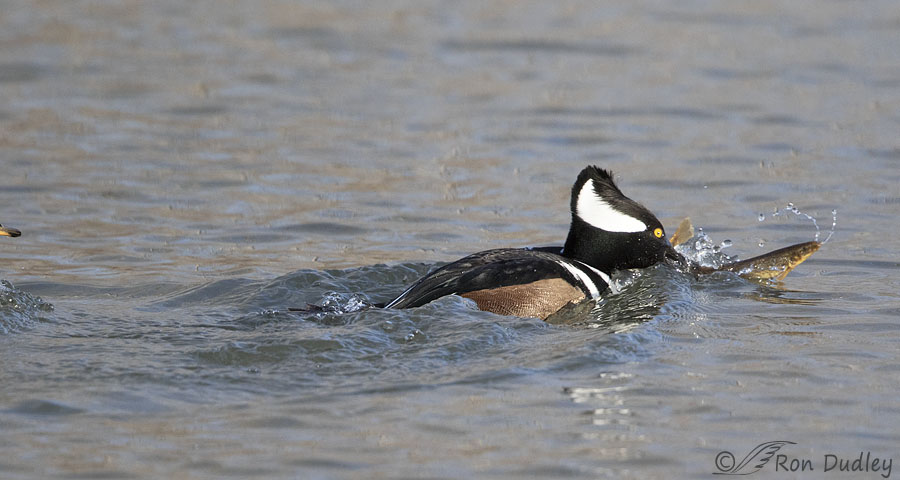
And to add to his troubles his lovely bride was after his meal – that’s her bill coming into the frame at left in a different crop of the previous image.
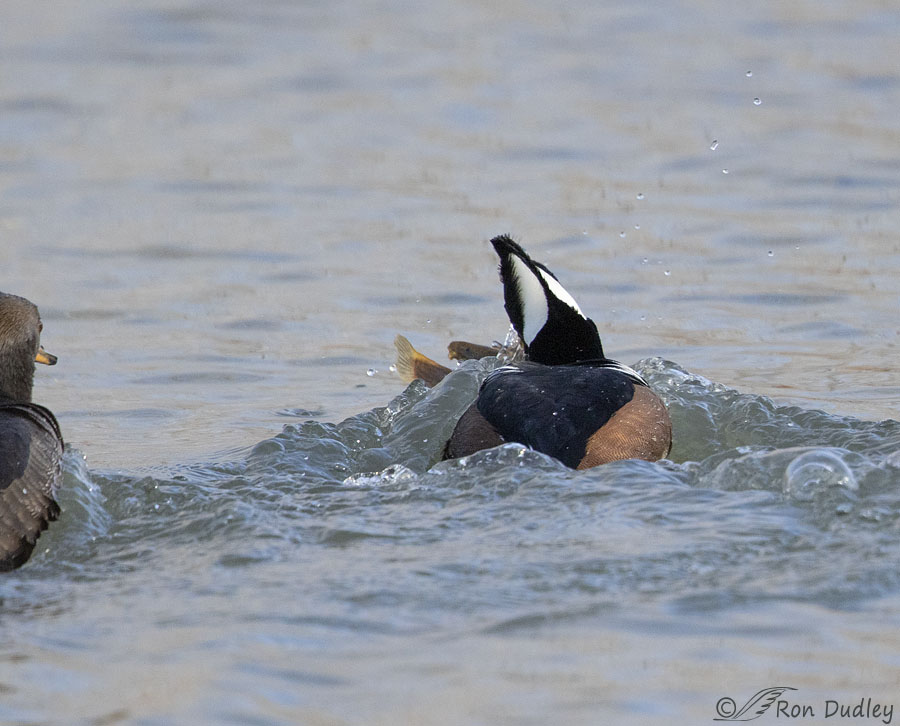
So he made a sharp left turn and fired his afterburners in order to escape the threat to his meal but she was hot on his heels.
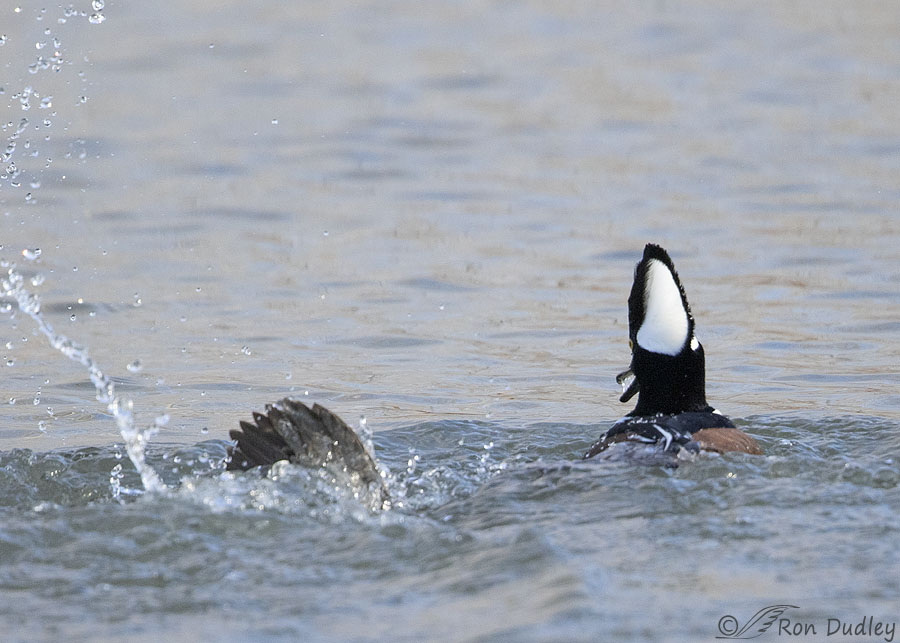
But then….. something strange. He dropped the fish, apparently deliberately (notice he’s stopped swimming away from her), and she dived to retrieve it.
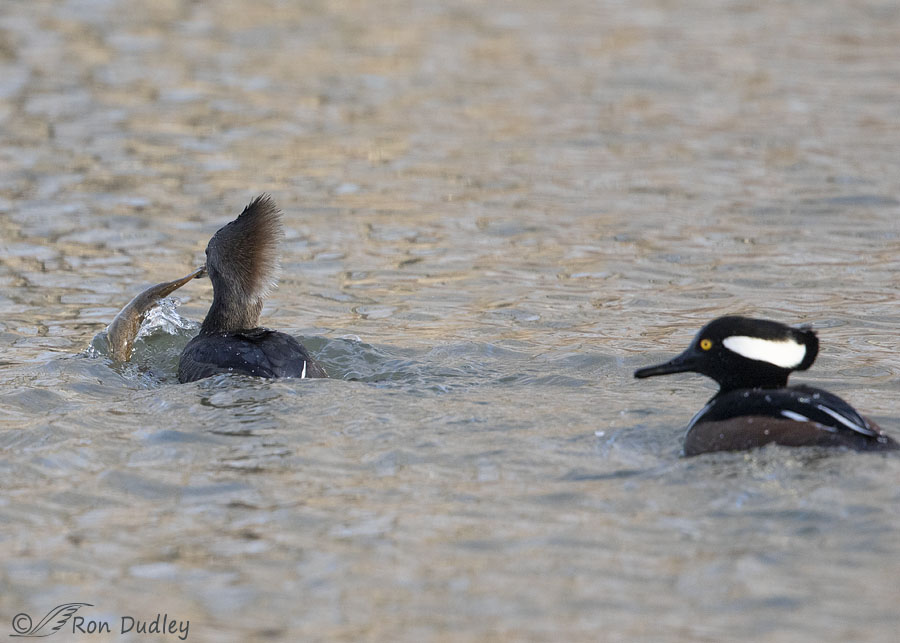
And she got it too, which he obviously allowed. He seemed to be watching with acceptance, at least at first.
But she had even more trouble than he did getting it down and eventually…
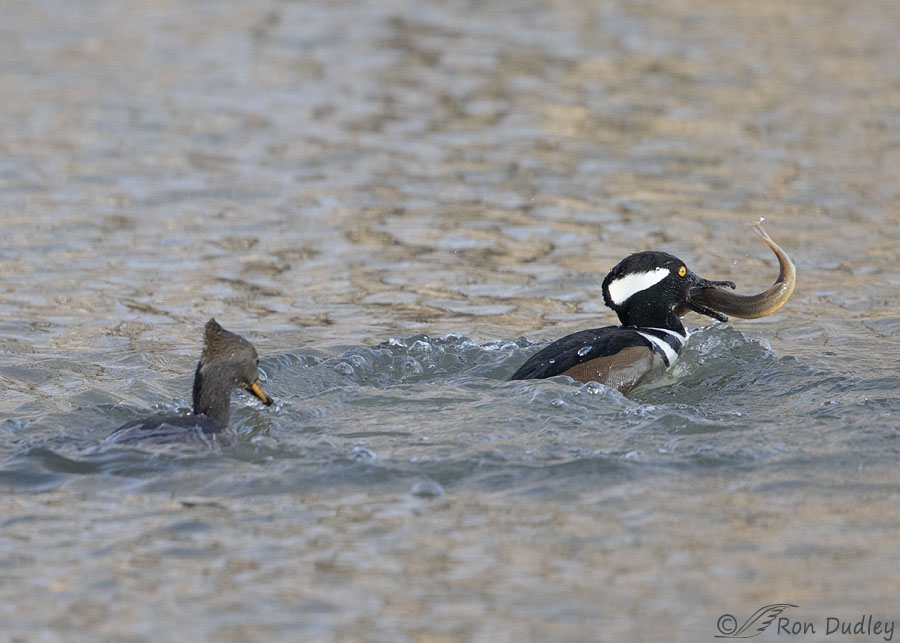
he somehow ended up with it again. The action during the exchange process (voluntary or involuntary) was fast and furious and I believe part of it was underwater so I didn’t get any shots that documented how it happened. But it did.
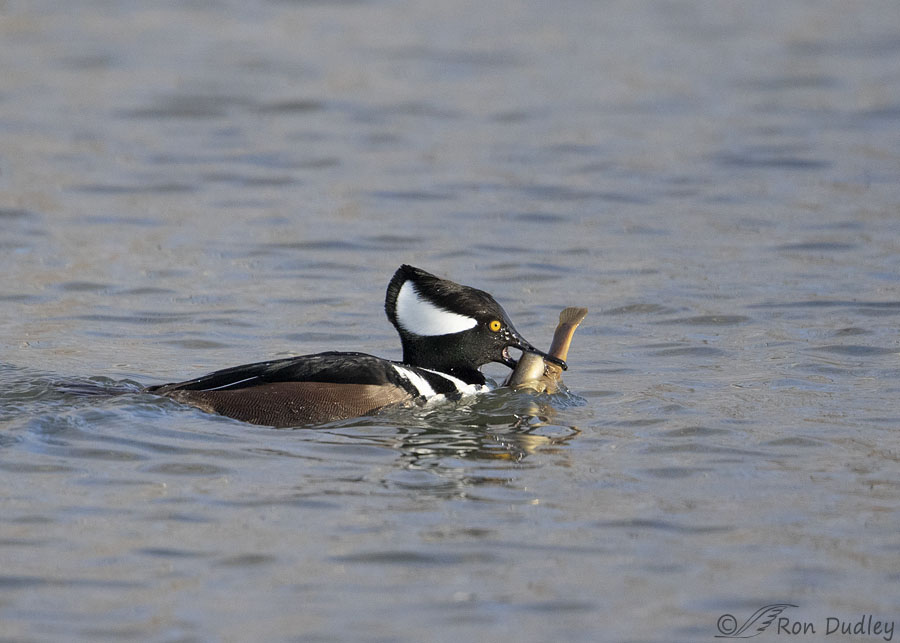
But the male couldn’t swallow that big loach quickly either…
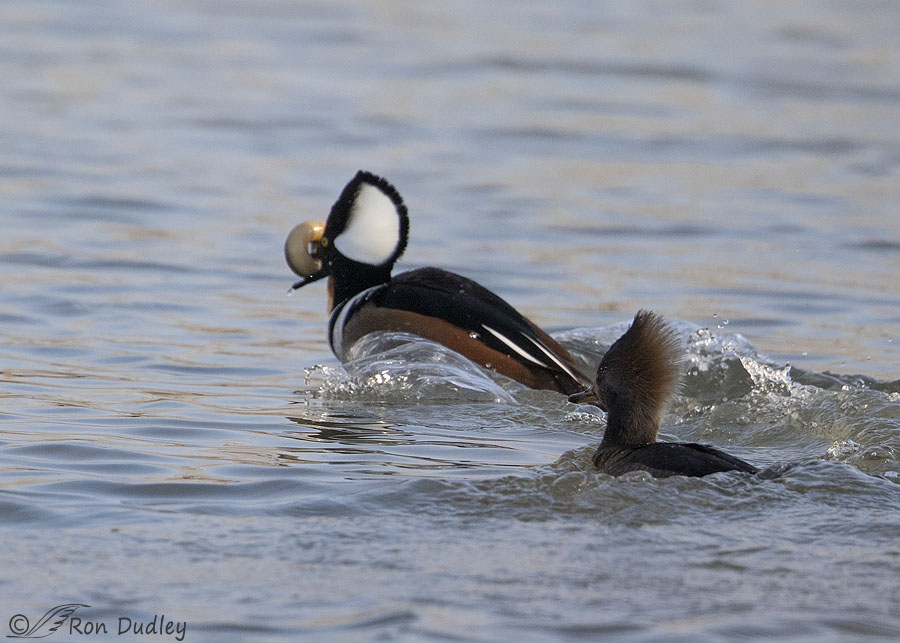
especially with the female still tracking him with what appeared to be less than honorable intentions.
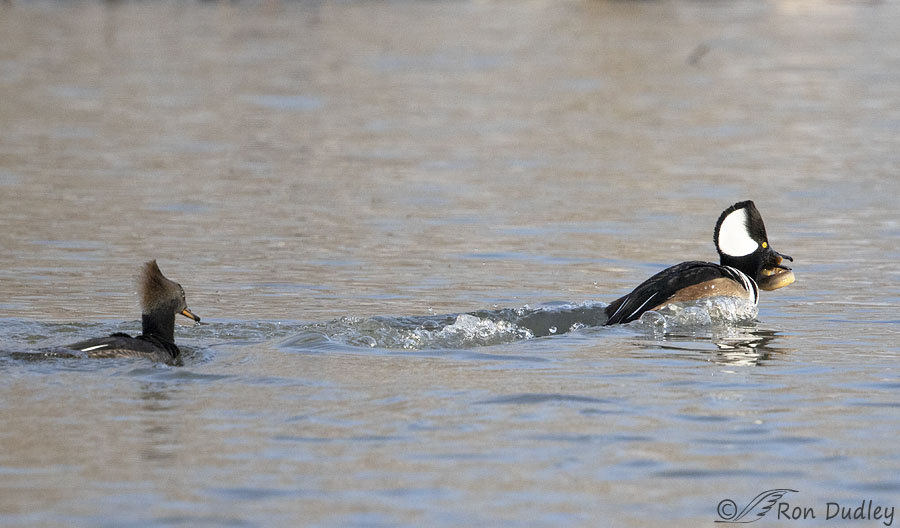
Her pursuit was slow but relentless and it seemed obvious that, at least at this point, he felt her intense interest threatened his meal.
By now both birds were far away so I stopped photographing them and don’t know what happened after I took this shot. I wish I’d continued firing away in an attempt to document the conclusion but I didn’t. Coulda, woulda, shoulda.
At first glance I assumed this encounter was nothing more than competition for food among mates with alternating “winners” but after looking carefully at these and other photos and upon reflection I’m not so sure. Consider the following:
- On a different occasion I saw the male drop a fish, apparently deliberately, with the female close at hand. I didn’t have sharp focus on either bird so I never pushed my shutter button but I could see it clearly enough through my lens to know what happened. However, I don’t know if the female got that fish but it seems to me that it might be more than coincidence that the male dropped a fish in front of his mate more than once.
- When the male dropped this fish and she came in to get it he made no immediate attempt to defend it or take it away from her.
- In many other species males give food to their mates (nuptial gifts) to reinforce their pair bond in a process sometimes called ritual feeding. I see it most often with Western Grebes, Clark’s Grebes and Loggerhead Shrikes but occasionally with other species too.
So I have to wonder if what I observed with these mergansers was just another form of ritual feeding where the male merganser “offers” the food to his mate by deliberately dropping it in her presence and allowing her to retrieve it rather than physically presenting it to her in his bill like grebes and shrikes do. After all, I did see him drop two different fish in her presence. In this case perhaps he took the fish back only when he saw it was too large for her to swallow. This species forms pair bonds early in the breeding season, as early as November, so if my working theory is correct the behavior would reinforce that bond.
I’m not convinced that’s the case but I do have to wonder.
Ron
Note:
I did try to research this subject but came up empty. Typically my most reliable source for information like this is Cornell’s Birds of North America Online (a pay site) – BNA usually provides extensive information on a variety of bird breeding behaviors but because with Hooded Mergansers “behavior and habitats used during breeding are difficult to sample and pre-breeding females are sensitive to disturbance” there seems to be large gaps in our understanding of many of their behaviors. As a result BNA often falls back on phrases like “no information available”, “little information available”, “no specific information”, “little known” or “no data available” when it comes to breeding behaviors of Hooded Mergansers.


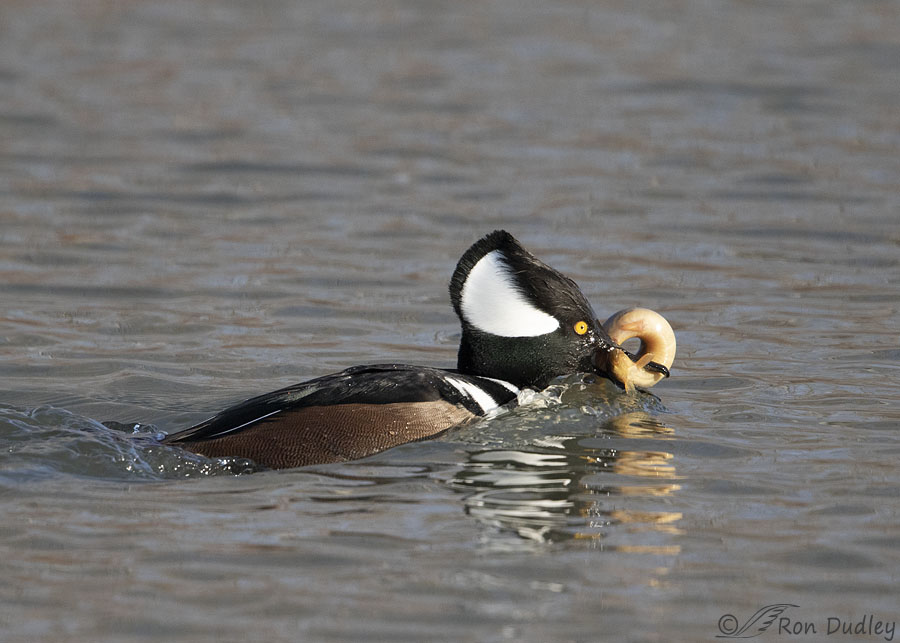
That is (or was) one huge loach.
On the behavioural front consider me simultaneously clueless and fascinated.
I don’t think I’ve seen a larger one, EC.
Huh…I thought it was a “bagel” in the one picture…not your fault at all- Loaches are very weird and I wish PetStores/fish stores would educate their Fish clients because it is just wrong to release exotics in our native areas. Thanks for your education.
I noticed how much the fish in that photo looked a lot like a bagel too, Diane. If it had been darker I’d probably have thought it looked like a chocolate donut…
Quick behavioral question for Ron or other commenters: a few times now I’ve seen male hooded mergansers cruising with their hood flattened and beak pointed straight at the sky, perpendicular to the water surface. Is this part of a display, just something they do while calling, or just general weirdness?
Amazing photos, I love watching mergansers compete over food; the common merganser males around here can really cause a lot of chaos when someone gets a juicy crab!
Pangolin, they have seven different courtship displays. What you describe sounds a lot like one of them.
Another fascinating but baffling bit of bird behavior. Thanks for documenting this. I remember seeing loaches in aquariums, but that’s it.
Yup, aquariums are their source as invasives, Lyle.
Are weather loaches an invasive fish? I’m not familiar with them other than here on your blog.
Yes, they’re invasive, Arwen. They’re kept by fish fanciers and when they get tired of them they release them into ponds and streams where they reproduce like crazy. They have that name because they’re sensitive to changes in barometric pressure and they become more or less active depending on the pressure so a lot of folks think they can predict the weather by watching their behaviors.
Maybe I should get some. Their weather forecasts couldn’t be more inaccurate than those of their human counterparts.
Lol just don’t let them go in a pond. Or flush them. I’ll bet they can survive that too.
I always learn something new from your posts. I wasn’t aware this species visited our area and the pictures are great both yesterday and today. I love your commentaries and speculations. You are a good story teller. I tries to comment yesterday but the site would not approve my email address.I’ll try this one. Great you are getting out again.
Glad it worked this time, Betty. And thank you for the kind words.
Great shots today and yesterday. The play of the light on the water is as beautiful as the birds, in my opinion, and those birds are pretty darn gorgeous. I can’t even begin to imagine what’s going on between the two lovebirds because I’m totally gobsmacked over the size of that loach. Dang!
There’s a lot of different colors reflected on the water in that area, Marty. Some of them make more pleasing photos than others. Thank you.
We have a good number of hoodies along the South Plattte River and reservoirs in the metro Denver area. I’ve spent hours watching and photographing them. Here hoodies mostly eat crayfish above the water surface. They cannot swallow a crayfish whole. So there is an extensive process of clipping off the claws before being able to swallow the body. During this process the crayfish fights for its life and other hoodies often try to steal the crayfish. I’ve never seen any indication of sharing food. This might be because of the number of other hoodies in good hunting areas, however, and the usual abundance of crayfish. If you know your partner can catch her own meal, and there’s a danger someone else would end up with yours, this is not a good place to offer her food. The privacy of your pair may have allowed behavior hoodies would enjoy here, but it’s simply not wise.
Yesterday I was impressed with how clearly your photo showed the feathers in the white part of the male’s head. That’s really hard, as you mentioned. Interesting, interesting post today.
Thank you, Nancy. Yes, these two birds were the only hoodies in the area and there were only a few other ducks.
Interesting and VERY fun to see! 🙂 Appears to me to be more “play” or part of the bonding process…..who knows! That was a large loach!
Yes, it was a big one. I’ve only seen one that large maybe twice before and I’ve seen hundreds of them caught by birds over the years. Thanks, Judy.
Amazing series Ron! Thanks for sharing!
Thank you, Charlotte.
What an interesting as well as puzzling series Ron. Wonder what they think as they observe us? I have often seen a scenario like this where the duck or grebe or heron or egret takes on something way too large and can’t get it down. Like you I have often given up after spending too much time and just feel that I have to move on, and in so doing I have missed the conclusion. As you say, “Shoulda, woulda, coulda.” What really interests me about this post is that after telling you about the abundance of Mergansers here and how often I see them I have never seen one catching a fish. I have seen them dive hundreds of times and often with my camera right on them, but never has one come up with a fish.
Everett Sanborn, Prescott AZ
Everett, this species also feeds on a lot of aquatic invertebrates such as insects so if that’s what your mergansers are usually feeding on they probably swallow them underwater and you wouldn’t see them surface with fish.
Most interesting post. They are so small but they have spunk! And that male… simply because of his ‘crown’ always seems to have a ‘chip on his shoulder’ swimming about with attitude. Can’t help but love him. I agree, the actions sometimes are a total puzzle but oh so interesting to watch and ponder. Was he impressing her or was she allowing him to impress her not to show him up? Did she fail in her endeavor to let him be macho? So many possibilities to consider… I totally enjoy your blog because you always provide much more than a ‘pretty picture’, you help to give insight and appreciation of what you photograph!
Yup, the more we learn about them the more we know we don’t know. That’s part of the fun of it. Thanks, Kathy.
Fascinating post along with beautiful photos today (and yesterday). What stunning birds! I have watched them once or twice from a distance and I Wish I had some light to shed on their mysterious behaviors but alas…
Thanks, Joanne. Behavior mysteries are part of the allure of birds but it’s always fun to try to figure them out.